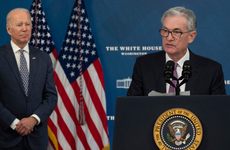Worried about surging inflation? Here’s how to protect your wallet from taking a big hit

The Bankrate promise
At Bankrate we strive to help you make smarter financial decisions. While we adhere to strict , this post may contain references to products from our partners. Here's an explanation for .
For more than a year now, Americans have been looking over their shoulders for an economic boogeyman: out-of-control inflation.
The jump has been eye-catching. Consumer prices in April soared 8.3 percent from a year ago, the first deceleration in eight months, according to the Department of Labor. But that also marks six straight months of inflation rising at a pace not seen since the 1980s and another eight months of price gains rising faster than the Fed’s desired 2 percent objective.
Follow the price of basic consumer necessities, and the impact on Americans’ wallets is clear. The average cost for a gallon of whole milk in February 2020 was $3.20. By April 2022, it reached $4.01, according to the Department of Labor. That’s almost $42 extra a year, assuming someone purchased one gallon a week.
“It means that households have to make tough decisions, month after month after month,” says Greg McBride, CFA, Bankrate chief financial analyst. “That has the most pronounced impact on consumers living paycheck to paycheck, and low- and moderate-income households.”
Experts say the inflation picture could get better, as pandemic-related threats recede, supply chain bottlenecks ease and higher interest rates zap demand out of the financial system. The ultimate question, however, is how quick that process will be.
Accounting for inflation is an important part of any consumer and investor’s financial plan. Here’s steps that both consumers and investors can take to better protect their finances.
1. Investors: Don’t drastically change your approach, but keep a diversified portfolio with some inflation-safe investments
From an investing perspective, you might not want to adjust your strategy all that much, particularly if you’re someone who’s in it for the long haul. But if a perfect inflation-safe strategy existed, someone would’ve figured it out by now. A diversified portfolio is your best bet.
“It’s hard to find a perfect inflation hedge: It doesn’t exist,” says Kristina Hooper, chief global market strategist at Invesco. “Investors have to recognize that, if they have a long enough time horizon, they typically are going to live through lower and higher levels of inflation over time, so to have components of a portfolio that typically perform well in inflationary environments is enough.”
Think about inflation’s winners and losers
What makes higher inflation particularly challenging is that “there’s not a whole lot of places to hide,” McBride says. “That’s why inflation can become a real stranglehold on growth.”
Those living on a fixed income, primarily retirees, might want to take greater care than others when crafting an inflation-friendly gameplan. Price pressures would erode your wallet if you have too much exposure to cash and fixed-rate return investments such as bonds.
“A well-diversified portfolio and one that’s appropriate for your goals and time horizon will contain some investments geared to outpace inflation,” McBride says. “The key ingredient is to save and invest and consistently build a well-rounded portfolio. The reality of it is, not everybody does that.”
Look for shorter-term and inflation-linked securities
Longer-dated bonds take a bigger inflation hit, meaning you’d probably be better off incorporating some bonds with a shorter maturity into your portfolio to offset the damage. But with rates on the rise, that situation could eventually change.
“At some point, those intermediate and longer-term bonds will hold some appeal again because they’ll pay better income and there will be less interest-rate risk,” McBride says. “But we’re not there yet.”
Another beneficial strategy can be to incorporate inflation-indexed bonds, the most common being Treasury-Inflation Protected Securities (TIPS). TIPS protect you from inflation by design. They pay a fixed interest rate every six months and an inflation adjustment on a semiannual basis, which applies to the bond’s face value, rather than its yield.
The “Series I” bond could also be an attractive option for those looking to maintain their purchasing power. Those fixed-income investments are going to pay a record 9.62 percent interest rate over the next six months, though it will inevitably fall again in tandem with inflation. There are caveats: Investors cannot touch their investment for one year and must pay three months’ worth of interest back if they cash in after less than five years.
“Inflation-adjusted, inflation-indexed or floating-rate bonds would provide a little bit more cushion than traditional bonds,” McBride says.
Consider growth stocks, dividend-paying equities and consumer staples
Stockholders tend to have a better chance at beating inflation. Companies generally pass along higher inflation in the form of higher prices, and the same market forces that increase inflation are also what tend to increase the value of companies.
That’s not to say it won’t be a bumpy ride. The S&P 500 has fallen about 17 percent since the start of 2022 as investors process the Fed’s aggressive policy stance to cool inflation.
Investors taking a longer-term view might want to incorporate some specific equities in their portfolio, one of them being a dividend-paying stock. Annualized dividend increases over time have outpaced inflation, Invesco’s Hooper says. “That doesn’t mean every year you’re going to outpace inflation, but if you’re taking a long view, that’s an interesting asset class to consider.”
You should also consider investing in stocks that have a high growth potential, according to Jordan Jackson, global market strategist at J.P. Morgan Asset Management. Those willing to look beyond the U.S. might find that emerging-market equities can also be a strong bet.
As always, however, keep your risk tolerance in mind and don’t make too many gambles. Think about which companies still have strong underlying fundamentals. Translation: Those meteoric rises like the GameStop phenomenon don’t often happen when inflation is high. Even Bitcoin, long praised as an inflation hedge, has plunged by more than 50 percent since November 2021.
“Stable, dividend-paying consumer staples could have their day in the sun” with higher inflation, McBride says. “High-growth companies that are long on expectations but short on current-day profits, those prices would be significantly undercut in a higher-inflation environment.”
Hard assets: Precious metals, commodities and real estate holdings
Having a broad basket of commodities could also help, as could owning some amount of precious metals. Both tend to be a safe haven from inflation. But lots of external factors influence those prices. They tend to be volatile, and they don’t pay a dividend or yield.
Real estate also tends to be a strong hedge, even in today’s highly inflated market. Property values tend to rise and fall in line with inflation, increasing the value of your investments.
“There’s a lot of support under the price of housing, especially in the near-term given the supply and demand dynamic,” says Lindsey Bell, chief markets and money strategist at Ally Invest. “Will it continue to appreciate at the pace seen over the past couple of years? Probably not, but there are fundamental factors in place that will allow the real estate market to continue to see price appreciation.”
2. Consumers: Save for poor economic conditions, plan ahead, and don’t keep too much cash on the sidelines
A clear loser during high inflation is simply the U.S. economy. The Fed historically had to manufacture a recession to stifle rampant inflation in the ‘70s and ‘80s. Higher inflation can also choke innovation, making it harder for companies to find funds for new investments and projects.
Many Americans know the drill: During recessions, it’s important to prioritize building up an emergency fund. And it’s always important to have an emergency fund worth at least six months of your expenses regardless of where savings yields or inflation stand.
But after that, higher inflationary environments are a particularly important time to make sure that you start searching for a better return — especially for consumers, who are losing purchasing power.
“With the same $100, we’re able to buy fewer amounts of goods throughout the economy,” J.P. Morgan Asset Management’s Jackson says. “You don’t want to have too much cash on the sidelines as we talk about losing your purchasing power, but you don’t want to have too little in the sense that things go wrong and you don’t have that safety net.”
Periods of high inflation also underscore the importance of keeping a prudent watch over your finances. Closely analyze where your money is flowing in and out each month and get a better sense of how you could be opening your wallet up to inflation.
The task is important because every consumer has a different inflation rate, depending on what they buy. Someone who rents and drives, for example, might feel a greater impact than people who invest a large proportion of their income. Meanwhile, someone who’s purchased a used car or new furniture over the past year might’ve been more susceptible to higher prices than others.
Once you have a better idea of how much inflation is hurting your wallet, you might be able to find ways to mitigate that impact. Technology, for instance, can be a handy tool to comparison shop almost any item or service. You might discover some discretionary purchases that you can eliminate, too.
“One of the best things that consumers can do right now is stop and take stock of what they’re spending,” Ally Invest’s Bell says. “Set a budget goal for yourself for each month and stick to it.”
Bottom line
The longer high inflation lingers, the harder it gets to penny-pinch. Nearly all (or 93 percent) of Americans said they had experienced higher prices over the past year, according to a March Bankrate survey. Almost 3 in 4 (or 74 percent) said those higher prices were hurting them financially, the poll also found.
That’s why inflation’s hoped-for slowdown is so pertinent: It might not erase the price gains, but the slower prices climb, the more likely households’ wealth will be able to catch up.
“If the pace of inflation moderates, that gives household buying power some time to catch up,” McBride says. “As opposed to now, where it’s eroding, even with a strong growth in income.”
Related Articles

Top high-yield savings accounts are now beating inflation. Here’s why that’s important

Inflation is crushing Americans’ savings — here’s 6 tips to protect your money

Red-hot inflation is raising prices on everyday essentials — here’s what’s rising the most

The worst inflation in 40 years: Here’s when price pressures could hit their peak